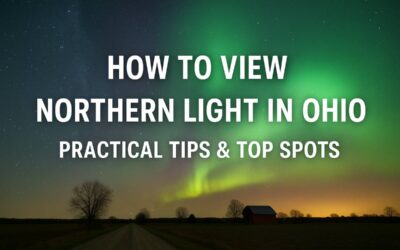How to View Northern Lights in Ohio: Practical Tips & Top Spots

Yes, You Can See the Northern Lights in Ohio — Here’s How!
Believe it or not, Ohioans can witness the magical Northern Lights (Aurora Borealis) without traveling to Alaska or Iceland. While it’s a rare event, strong solar storms can push the colorful lights far enough south that they illuminate Ohio’s skies—especially in northern and rural areas.
If you’ve ever dreamed of watching green, pink, or violet ribbons dance above you, this guide will show you exactly how, when, and where to make that dream come true. Think of this as your personal aurora tour guide for Ohio — complete with insider tips, top viewing spots, and real-time resources to help you catch this rare natural show.
What Are the Northern Lights, and Why Ohio?
The Northern Lights, or Aurora Borealis, occur when charged particles from the Sun collide with gases in Earth’s upper atmosphere. These collisions release energy in the form of colorful light displays that swirl, ripple, or glow across the night sky.
Normally, you’d have to head near the Arctic Circle to see them clearly — think Alaska, Norway, or Canada. But during strong geomagnetic storms, that auroral activity expands much farther south — sometimes reaching states like Michigan, Indiana, and even Ohio.
Here’s the good news:
We’re currently in a solar maximum cycle (2024–2026) — a period of intense solar activity. This means more frequent and vivid auroras, even for places that rarely get them. Ohio is one of those lucky spots now on the aurora radar!
Best Time to See the Northern Lights in Ohio
Timing is everything when it comes to aurora hunting. Here’s what you need to know:
Season: September to March
During these months, nights are longer and darker, creating ideal viewing conditions. The spring and autumn equinoxes (March & September) often bring stronger solar activity, so keep an eye out during those periods.
Time of Night: 10 PM – 2 AM
Most auroras appear late at night when the sky is darkest and geomagnetic activity peaks. If you’re serious, plan to stay out until midnight or later — patience pays off.
Solar Cycle Advantage
We’re in an active solar phase, which means auroral displays may occur multiple times a year. According to NOAA, 2025 is expected to be one of the most aurora-active years in two decades.
Pro Tip: Follow the “Kp Index” — a scale from 0 to 9 that measures geomagnetic activity.
If the Kp Index is 6 or higher, there’s a good chance Ohio’s skies might light up!
Where to See the Northern Lights in Ohio: Top Spots
When chasing the aurora, light pollution is your biggest enemy. You’ll need to head away from city lights to areas with clear, open horizons facing north. Here are some of the best aurora-viewing spots across Ohio — handpicked for stargazers like you.
1. Headlands Beach State Park – Mentor, OH
- Why Go: One of Ohio’s best dark-sky areas on the shores of Lake Erie. You’ll get an unobstructed northern horizon — perfect for catching that first glow.
- Travel Tip: Bring a blanket or chair and set up near the observation tower or the main beach area.
- Nearby Amenities: Restrooms, parking, and a few local diners that stay open late.
2. Cuyahoga Valley National Park – Between Cleveland & Akron
- Why Go: It’s a national park, so light pollution is minimal, and the rolling landscapes give wide sky views.
- Best Viewing Spots: Kendall Lake, Brandywine Falls, or the Towpath Trail overlooks.
- Travel Tip: Bring a flashlight with red light mode — it helps you see without ruining your night vision.
3. Maumee Bay State Park – Oregon, OH (Near Toledo)
- Why Go: The northern horizon faces Lake Erie, offering mirror-like reflections of the aurora on the water — stunning for photography!
- Best Spot: The Lodge shoreline or Maumee Bay boardwalk.
- Travel Tip: Stay at the park lodge — it’s cozy and right by the water. You can literally step out and skywatch.
4. Lake Erie Bluffs – Perry, OH
- Why Go: High cliffs overlooking the lake provide one of the most breathtaking vantage points in Ohio.
- Best Spot: The observation tower — it’s elevated and gives a wide, panoramic northern view.
- Travel Tip: Bring binoculars and a thermos of hot cocoa — it gets chilly up there at night!
5. Mohican State Park – Loudonville, OH
- Why Go: Even though it’s farther south, Mohican’s low light pollution and wide meadows make it a great backup spot during strong solar storms.
- Travel Tip: Camp overnight and enjoy stargazing even if the aurora doesn’t appear — it’s a dark-sky paradise!
How to Spot the Northern Lights: A Step-by-Step Aurora Guide
Let’s make this easy. Imagine you’re planning an aurora outing — here’s your step-by-step tour plan:
Step 1: Check Aurora Forecasts
Use these trusted tools:
- 🌐 NOAA Space Weather Prediction Center
- 📱 Apps: My Aurora Forecast, AuroraWatch, or SpaceWeatherLive
- Watch for Kp Index ≥ 6 for best chances in Ohio.
Step 2: Watch the Weather
Clouds are the enemy!
Use apps like Clear Outside or AccuWeather Sky Map to find cloud-free areas before heading out.
Step 3: Escape the City Lights
Drive at least 30–60 miles from major cities (Cleveland, Columbus, or Cincinnati). The darker your surroundings, the brighter the aurora will appear.
Step 4: Get the Right Gear
- Camera: DSLR or mirrorless with manual mode.
- Settings: ISO 1600–3200, aperture f/2.8, exposure 5–15 seconds.
- Tripod: A must-have for sharp photos.
- Extra batteries: Cold drains them fast!
- Comfort items: Warm clothes, blankets, and snacks.
Step 5: Look North and Be Patient
Auroras can flicker in and out. Sometimes they start as a faint white haze before bursting into color. Keep your eyes adjusted to the dark — and resist the urge to check your phone screen too often.
Real Aurora Sightings in Ohio: Yes, It Happens!
If you think it’s all talk — think again.
In May 2024, residents across Cleveland, Toledo, and Columbus saw glowing bands of green and purple light stretching across the sky. It was part of a G4-level geomagnetic storm, one of the strongest in 20 years.
Local photographers captured stunning time-lapse videos showing auroras reflecting off Lake Erie, proving that Ohio can absolutely light up under the right conditions.
Fun Aurora Facts for Ohio Skywatchers
- The color of the lights depends on which gas is hit:
- Green = Oxygen (most common)
- Red = High-altitude Oxygen
- Purple = Nitrogen
- The lights typically appear 60–200 miles above the ground.
- The word “Aurora Borealis” means “Dawn of the North” in Latin.
Did You Know? The southern version of the Northern Lights is called Aurora Australis — visible from Antarctica and southern Australia.
Stay Notified: Aurora Alerts You Can Trust
Never miss an event again!
You can sign up for instant alerts via:
- Aurora Alerts App (SoftServe)
- SpaceWeather.com email updates
- Follow @NWSSpaceWx or @SpaceWeatherLive on X (Twitter)
These alerts tell you when a solar storm is approaching, what Kp level to expect, and how far south the lights might reach.
Final Words: Your Ohio Aurora Adventure Awaits
Seeing the Northern Lights in Ohio is not a daily event — but when it happens, it’s magical. With the solar maximum peaking between 2024 and 2026, your odds have never been better.
So next time you hear about a geomagnetic storm alert, don’t just scroll past it — pack a camera, grab some friends, and head north toward Lake Erie. You might just find yourself standing under a sky painted with ribbons of green and purple, realizing that sometimes, extraordinary beauty happens in the most unexpected places — even in Ohio.








